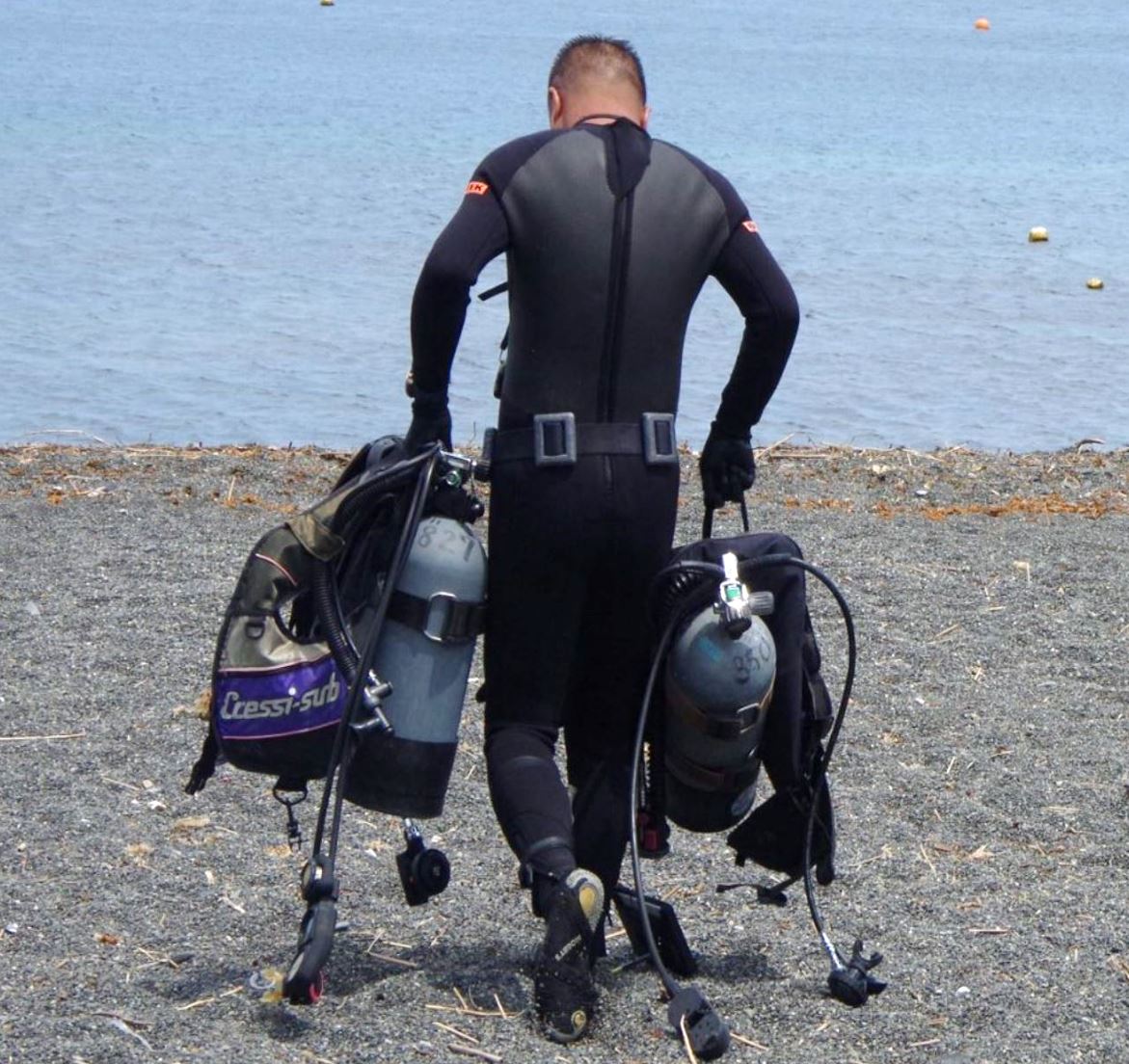
Hideki's Yuruyuru Nagisahoki/ep5 -Washed Garbage Encyclopedia-
2020/01/31- text and edit by
- Hideki Sato
Kotoyoro
Happy New Year everyone (Pekori)
(It's already been a long time since the beginning of 2020, but...)
This year as well, I will write articles that are far from trend information and cutting-edge technology like other nomlog articles, so don't overdo it and read it when you really feel like you have time. I would be happy if you could.
This time's story is the second of "Nagisa's Collection", so I would like to look at the drifting objects from a different perspective than the previous [Ikimono Encyclopedia].
Then, as usual, let's go to Shonan Chigasaki Beach, Hideki's My Field, together!
 *Today's beach is nice because there is almost no artificial garbage.
*Today's beach is nice because there is almost no artificial garbage.
Actually, there is a reason for this nice beach scenery.
 *There is a pile of garbage bags here! Who the hell dumped so much trash?
*There is a pile of garbage bags here! Who the hell dumped so much trash?
No, it's not illegal dumping.
Every Sunday morning, local volunteers pick up trash.
I overslept and haven't been able to participate yet, so my head is really down (sweat)
I'm sorry to say this, but I once thought about picking up trash as an individual activity, but in addition to the amount of trash being too much, I ran into a wall of difficulty in transporting and disposing of it. It has not been realized.
For that reason, this time, as well as atonement for that sin,
"Let's think about marine environmental problems from beach garbage!"
I would like to talk to you.
But that alone doesn't make it a "loose post", so
While I'm going off the rails, let's talk about drifting objects, shall we?
...... I also think.
Please see this photo. * This is the exhibition corner for [Environmental Issues Surrounding the Sea] at the Kamo Aquarium, which is famous for its jellyfish exhibition in Yamagata Prefecture.
* This is the exhibition corner for [Environmental Issues Surrounding the Sea] at the Kamo Aquarium, which is famous for its jellyfish exhibition in Yamagata Prefecture.
The key points of marine pollution are written in handwriting on the blackboard in an easy-to-understand manner, so let's read it.
"Most of the marine debris, including plastic, comes from the land via rivers."
"Most of it is garbage that comes out in life"
Isn't this a shocking fact?
That's right, most of the marine garbage is not directly dumped into the ocean, and 80% of it is said to come from cities.
Garbage that is littered or thrown into the city for some reason will eventually be carried by rainwater and wind, go through drainage ditches, sewers and rivers and reach the sea.
"Garbage in the sea is carried around the world by the wind and ocean currents."
"There are areas in the Pacific Ocean where drifting garbage tends to collect,
the 'Great Pacific Garbage Patch' and 'Plastic Soup' ."It's been called
Earlier, I talked about [bottle messages] that lead to the world through the sea.
It's "Plastic Soup"! I don't want to drink even if I'm a glutton. As you all know, the problem of plastic waste that does not decompose naturally is serious. If we categorize garbage by material, it is said that about 2/3 (number ratio) is plastic garbage such as PET bottles and plastic bags. By 2050, there will be more garbage in the sea than fish.
In addition, there are many reports of damage to living things caused by microplastics, plastic bags, and fishing lines.
In recent years, there has been an increase in the number of aquariums that appeal to the protection and conservation of the natural environment through exhibition content that deals with such environmental issues.
Originally, an aquarium, which conveys the splendor of living things and nature by letting visitors see the fish swimming gracefully in the tank, should play the role of presenting visitors with a negative reality.
I also want to contribute to environmental conservation and protection activities through this blog, but if I were just an old man shouting, "Take care of nature!" and "Let's reduce plastic waste!" because we know
Get curiosity and interest in [Nagisa's drifts]!
From there, I would like to know the actual situation of the natural environment and garbage.
Now, let's go back to the Chigasaki coast and see the [washed-up garbage] that has arrived at the beach!
Shonan Coast Beached Garbage Circumstances
 * The state of the beach the day after the sea was rough. PET bottles and empty cans stand out (If you look closely, you can see Shimajiro!)
* The state of the beach the day after the sea was rough. PET bottles and empty cans stand out (If you look closely, you can see Shimajiro!)
We think that these garbages are conspicuous for the following reasons.
1. Being able to float on water makes it easier to be carried long distances by waves and wind
2. Because it floats on the surface of the water, it is easier to wash ashore than sinking to the bottom of the water, and its existence as garbage comes to the surface.
3. I feel uncomfortable being in a natural environment
A lot of driftwood also drifts ashore, but in addition to the fact that it does not apply to 3. In addition, microorganisms will naturally decompose it eventually, so this time we will focus only on artificial debris.
One thing that always makes me wonder is finding trash from containers of products that were discontinued years ago among the new trash. Such empty containers have corroded metal and worn printed parts, so you can feel that "this child has traveled a long time", but for that many years, natural decomposition It can be said that they were wandering around various places as garbage.
Now let's look at sorting garbage.
Plastic type washed ashore garbage
 *Look at this wide variety of things. Variety just like a large-scale mass retailer!
*Look at this wide variety of things. Variety just like a large-scale mass retailer!
Photo 1.
I tried to collect the garbage that was scattered around. I think you can really feel the words I mentioned earlier, "Most of them are garbage generated in our daily lives." Paper, metal, and glass materials are mixed in, but you can see that 80% of the garbage is plastic. The bottle in front is still full of tea. I often see products with contents inside or unopened, so I think it's not just about littering.
Photo 2.
Dracula teeth? Toy dentures that imitate. I found real dentures, and I was terrified at that time (sweat)
Photo 3.
Jug for water supply. On the riverbed of the Sagami River that flows right next to this beach, there are many grounds for baseball and soccer, so you can see many water bottles that probably belong to baseball boys and soccer kids. Instead of throwing it away, it may have been left behind on the ground, or it may have been blown away by a strong wind and washed away by a river due to heavy rain. (I hope so)
Photo 4.
It's a triangular cone, but is this also related to sports? I can't rule out the possibility that it rolled off the road.
Photo 5.
The 100-yen lighter stands out because of its bright color. I found 20 of them in about 30 minutes of walking on the beach. It's not uncommon for some to still have gas left. (I put them all in my pocket and took them home and disposed of them.)
Sphere, washed ashore garbage (BALL)
 * A wide variety of spherical garbage. I see it so often that there is no day I can't find it
* A wide variety of spherical garbage. I see it so often that there is no day I can't find it
Photo 6.
This super bowl is the most common. Since the momentum is often small, the probability of losing it while playing on the road etc. is high. Since it floats in the water, there is a high possibility that it will be accidentally eaten by fish or other creatures, so I try to bring it home as much as possible when I find it. (We have about a full bucket in our house)
Photo 7.
There is a golf course and hitting range right next to the beach, so there is never a day when you don't see a golf ball. By the way, golf balls don't float on water, so I don't think they can travel to the oceans of the world by themselves.
Photo 8.
hard tennis ball. It is an interesting picture that there are many seeds of plants that cling to the fur of animals and birds and disperse, commonly known as "sticking insects".
Photo 9.
This is also a rubber baseball ball that is a messenger from the riverbed. The balls in the photo are pretty worn, looking like they've traveled many months. Softball has a bit of an interesting consideration, so I would like to take it up on another occasion.
Photo 10.
Character balls come in many varieties. I wonder if it's a good idea to put it in this genre, but once I found the trademark "Dragon Ball" with the orange star, for a moment I seriously thought, "I've got something amazing!" There was (laughs) Material-wise, it was a transparent synthetic rubber, so should it be classified as a superball?
Photo 11.
A soccer ball that would have come from the riverbed as well as baseball. Indoor basketball and volleyball are rarely seen.
Photo 12.
A bowling ball that makes you think, "Why again?" It might be a little interesting to see the structure of the ball broken.
According to research, some bowling balls float and some sink around 12 pounds. This is because the weight per volume is the point, and about 12 pounds is close to the specific gravity of water.
(I write "ball" in ball games such as baseball, but am I the only one who feels more comfortable with "ball" in bowling?)
Photo 13.
It is a [floating ball] used for fishing. It used to be a glass ball, right? As expected, I've never found it on the beach in Shonan.
Ball-type garbage is made for the purpose of ball games, so it is highly durable, has the property of easily floating on water, and rolls even with the wind, so it can be said that it is garbage that is good at moving here and there and drifting. . There is Styrofoam in garbage of similar properties.
Marine waste
 *Shoes and sandals are also one of the items we often see.
*Shoes and sandals are also one of the items we often see.
Photo 14.
I gathered this much just by looking around the beach. There are still many things that can be worn, so I would like to vote for the "lost theory". It is speculated that the things that were taken off when entering the sea or river were swept away by the waves and currents. Sandals are washed ashore garbage that increases especially in the summer. Because the foam material is used for the sole, it probably floats on the water and is easily washed away. By the way, in Hokkaido, Aomori, Akita, etc., it seems that they say "wear gloves", so work gloves are also included in the group.
Photo 15.
I once got stuck in the sludge at the mouth of the river and my Crocs got entangled in the mud, making it impossible to recover. It's dangerous to go home barefoot, so I searched for sandals made from ashore and borrowed them. As expected, it's difficult to get the same thing on the left and right (although I don't like horse racing), but isn't the pairing of color, shape, and size a good line?
Looking at the current state of footwear waste, I think that plant-based sandals, clogs, and setta are eco-products that decompose naturally.
FISHING-type washed-ashore garbage
 * Rather than garbage, it is often a "treasure" for me.
* Rather than garbage, it is often a "treasure" for me.
Photo 16.
It is a saltwater (seawater) lure. The Shonan coast is said to be the birthplace of salt lure fishing, and attracts many enthusiasts.
The tip of this lure's hook is still sharp, so you can tell it's just lost. Even if it is for seawater, the hook is easily corroded and dissolves in seawater, so a lure without a hook is proof that it has been adrift for a long time.
Photo 17.
This is a lure for black bass named "Pink Panda". Most likely it came from a river, as no one uses this lure in the ocean. When I looked into it, it was already out of production, and it was a little rare item with collectors. This lure was missing a hook and may have had a long drifting trip.
Photo 18.
Many people throw away tangled lines (fishing lines) on the spot. As a fellow fisherman, it is embarrassing to pollute the nature while letting me play in it. The fishing line is strong and hard to cut, and it can get tangled in the legs of birds, so I make sure to retrieve it whenever I find it. So, I always bring scissors and pliers for line cutting when I take a walk on the beach. Because the hook of the lure got stuck in my leg and I couldn't get the pliers out (scary!)
In the case of a drifting lure, there is almost a 100% chance that it is lost. I have many experiences of losing myself by cutting the line (fishing line) or hooking it on rocks or debris in the water. Each time, I apologize by muttering, "I'm sorry for nature." Since it is an item that is often lost, attempts are being made to make lures that are friendly to the natural environment and are made from materials that naturally decompose.
Figure series drifting garbage (I can't bear to call it garbage, but...)
 * There are a lot of surreal photos, right?
* There are a lot of surreal photos, right?
Photo 19.
One-legged Seven. Lying in a pose that fires his signature move "Islugger" and the pink body with the trade color red fading adds to the pitifulness. If you look closely, you can see that barnacles are attached to the remaining leg and that it has been drifting in the sea for a long time.
(When I was a kid, I always thought it was "Ice Slugger", but the correct answer was "I Slugger")
Photo 20.
PDT Bear, born in England, sunbathing. Around this time, PDT Bear was on an adventure around the world in a movie, so I thought he took a detour to Shonan (lie). When a stuffed animal drifts ashore, I feel a little sad, so I gently place it on the driftwood.
Photo 21.
There are three faces in "Tower of the Sun", the work of the artist who is familiar with "Art is an explosion!", but there are only two faces, probably because it really exploded. I still vividly remember seeing the Tree of Life in the Tower of the Sun with my family when I was in the first grade at the time of the Osaka Expo in 1970.
Photo 22.
Where did the rider himself who took off the mask go? Did he leave the fight against the evil organization to his juniors and set off? (If you leave the mask there, it will be illegal dumping! We will keep it at home, so please let us know.)
Photo 23.
Captain Harlock with a crimson cloak fluttering in the wind. Sounds like a scene from a live-action movie, right? (Even though I say that, I haven't watched anime or movies, apparently I'm a space pirate)
Photo 24.
Saltwater crocodiles come ashore from the sea and hide behind driftwood to wait for prey to pass by. I managed to escape in the nick of time, but it was dangerous! (again lie)
Photo 25.
A half-fish man who lost an arm? alien? encountered. When I heard the story, it seems that it is called "Kappa Genjin". It seems that he came to the sea with "Kappa River Flow".
In fact, when I searched the internet for what kind of character he is, the characters "Bull Mark" engraved on the back of his leg, it seems that he is a rare character who appeared in a live-action hero show called "Tetsujin Tiger Seven" in a small role only once.
Photo 26.
Wave Zappan in the background! A rider who appeared like that. (I don't know how many riders I have, but I have a senior's mask!)
In this way, I have met various heroes and characters, but every time I see them abandoned and tattered, it makes me feel sad. Those who have given dreams and courage to children become garbage, and this time they become villains who pollute the earth. They probably aren't the main ones.
Other various drifted garbage
 ※Let's take a look at the wide variety of other interesting drifted garbage
※Let's take a look at the wide variety of other interesting drifted garbage
Photo 27.
Some young people don't know what this is, right? For me, this cassette tape is “memories of youth”. I used to make original cassettes with my favorite songs~ (far eyes) Even if you play nostalgic music, please don't throw old cassette tapes into the ocean.
Photo 28.
It's not a summer scene where families and groups come to the beach. It can be said that it is a seasonal item, a summer feature, and a drifting item (lost item).
Photo 29.
It is not uncommon to find branded wallets and bags. I'm glaring that it's a crime-related drift. From my experience, there is a 100% probability that there is no cash in it, and cards are often left behind, so it is highly unlikely that the owner himself threw it away. The thieves probably just took the cash and threw it into the river or the sea to destroy the evidence. It is also a moment to catch a glimpse of the dark side of the world.
Photo 30.
When you find amulets, amulets, stupas, and other items related to Shinto rituals or religious items washed ashore, you will be instantly stunned.
Photo 31.
As shown in the photo, we often see drifted car tires that have lost their side parts called [beads] and [sidewalls]. At first, I thought it would be scraped off as it crawled along the sandy bottom of the water, but one day I found a tire with a cross section that looked like it had been cut with a knife, so I looked it up on the internet. From what I've seen, it seems that a special tool is required to remove the old tire without damaging the wheel, so it may be cut off with a cutter or the like. It costs money to properly dispose of tires, so some people throw them in the sea or river (or riverbed). This is part of the darkness of the world.
Photo 32.
This is not a plastic bottle. 1 liter size glass bottle. It was released in the 1980s, and at that time it was collected and reused as a returnable bottle, just like beer bottles. If I recall correctly, a security deposit of 30 yen (10 yen for the small size) was added to the price of this size, and when I took it back to the shop where I bought it, the amount was returned. Currently, it seems that it is traded for several hundred to several thousand yen among collectors.
Photo 33.
Is it a pillow? It was the first time I saw drifted garbage, so I couldn't help but take a picture. If the cover or inner cotton is made of synthetic fiber, it will not decompose naturally like plastic, so it will be troublesome garbage.
Photo 34.
Ship-type wreckage is not so rare, but compared to the size of the hull where only one person can get on, a fairly large engine (usually outboard motors are common for this size) is a midship (body of the body). It is placed in the center of gravity for better turning performance). I had no idea what the purpose of the boat was. (A landing boat for northern infiltration?)
What I learned from drifting garbage
 *The scenery of the beach without garbage is still beautiful.
*The scenery of the beach without garbage is still beautiful.
In addition to this, I have also seen many types of drifted garbage that cannot be introduced here.
It is said that “garbage is a mirror that reflects life and society”.
I wrote something similar in the text, but "In addition to malicious garbage intentionally thrown into the natural environment as waste, there are actually more things that have become garbage due to unforeseen events. Isn't there something?"
When considering the reduction of marine litter, it is just a matter of morals that people do not throw away litter.
I feel that I have learned from the beach litter that it is important that various efforts to prevent such "accidental waste disposal" spread throughout society.
(This time, it was a little social article ~)
Next time, as the third installment of "Nagisa's Collection", we are planning to deliver a slightly different "Wracked Objects Quiz".
*If you like, please check out the back number of "Yuruyuru Nagisahouki"!
(Text & photo by Hideki Sato)
——————————————————————————————————————-
"Hideki's Yuruyuru Nagisahoki" Click here for the back number!
ep8 "Look for discomfort!" Quiz 2 ep7 "What is this?" Quiz ep6 "Beach of Corona"
ep5 "Encyclopedia of Garbage Ashore" ep4 "Encyclopedia of Living Things" ep3 "Natural Perception" ep2 "Bottle Message"
ep1 "Coastal Museum"
Like this article?












